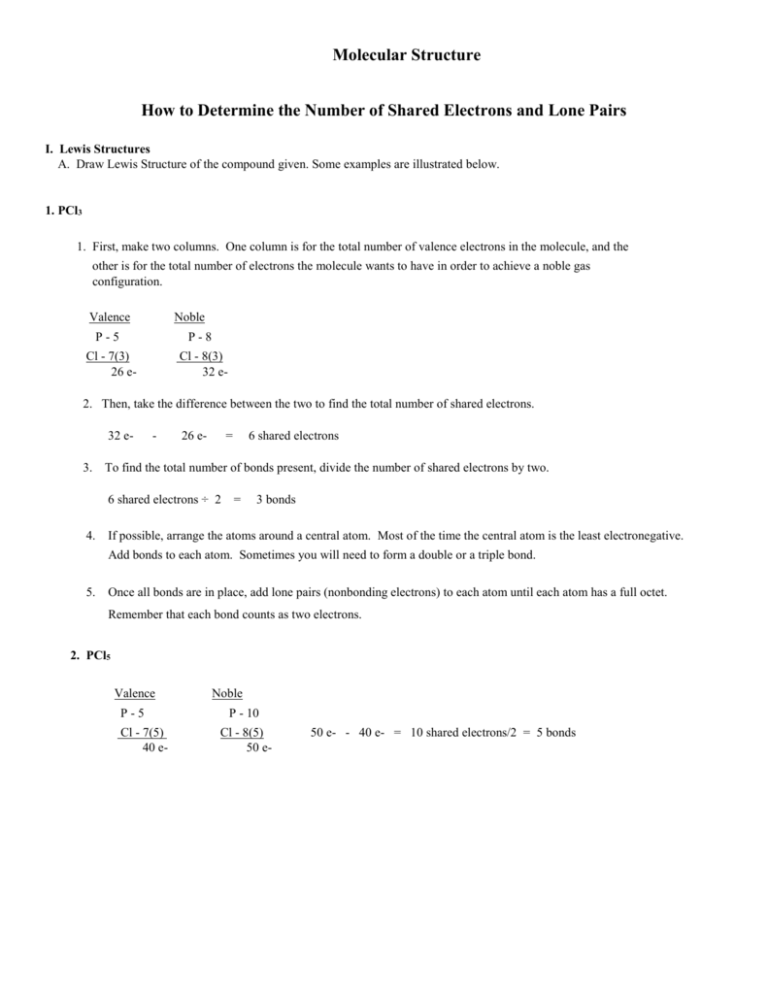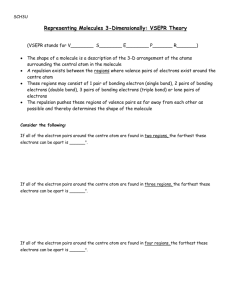Molecule Polarity
advertisement

Molecular Structure How to Determine the Number of Shared Electrons and Lone Pairs I. Lewis Structures A. Draw Lewis Structure of the compound given. Some examples are illustrated below. 1. PCl3 1. First, make two columns. One column is for the total number of valence electrons in the molecule, and the other is for the total number of electrons the molecule wants to have in order to achieve a noble gas configuration. Valence Noble P-5 P-8 Cl - 7(3) 26 e- Cl - 8(3) 32 e- 2. Then, take the difference between the two to find the total number of shared electrons. 32 e- - 26 e- = 6 shared electrons 3. To find the total number of bonds present, divide the number of shared electrons by two. 6 shared electrons ÷ 2 4. = 3 bonds If possible, arrange the atoms around a central atom. Most of the time the central atom is the least electronegative. Add bonds to each atom. Sometimes you will need to form a double or a triple bond. 5. Once all bonds are in place, add lone pairs (nonbonding electrons) to each atom until each atom has a full octet. Remember that each bond counts as two electrons. 2. PCl5 Valence P-5 Cl - 7(5) 40 e- Noble P - 10 Cl - 8(5) 50 e- 50 e- - 40 e- = 10 shared electrons/2 = 5 bonds Molecular Structure Molecule Polarity Step 1: Draw the Lewis structure. Note the number of electron regions around the central atom, and of these which are bonding or lone pairs (non-bonding pairs) Step 2: Use this info to determine the 3D geometry of the molecule. You do this by remembering "VSEPR". Valence Shell Electron Pair Repulsion theory; around the central atom all regions of electrons repel each other to get as far away from each other as possible while pivoting around the central atom. Note that double bonds and triple bonds count as a single region of electrons. Step 3: Determine if the molecular is polar or non-polar - a molecule is (i) non-polar if the charge distribution is symmetric and (ii) polar if the charge distribution is asymmetric (not symmetric). The Decision Process: After you draw the molecule in 3D representation using VSEPR rules, if the molecule has symmetry around the central atom, the bond dipole moments will "cancel out" (like pulling in opposite directions) and the molecule will therefore be non-polar. However, if the molecule is asymmetric, the bond dipole moments won't "cancel out" and the molecule will have a net dipole moment and the molecule is therefore polar. Alternative Method Step 1: Draw the Lewis structure. Note the number of electron regions around the central atom, and of these which are bonding or lone pairs (non-bonding pairs) Step 2: Draw the charges in place of electrons. Designate nucleus as positive. Step 3: Compare the two corner ends, if one is (+) and other is (-), classify the molecule as polar. If both ends (left and right) are same charges, the molecule is non-polar. Molecular Structure







